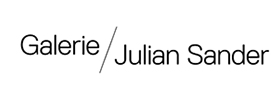
Turk and Robert, Monterrey, Mexico, 1958
Archival digital pigment print
Ed. of 25
29 7/8 x 29 7/8 in. (76 x 76 cm)
© 2014 Larry Fink, courtesy by FEROZ Galerie, Bonn
Larry Fink »
The Beats
Being on the Beat
Exhibition: 16 Jan – 27 Mar 2015
Thu 15 Jan 19:00 - 21:00
Feroz Galerie
Prinz-Albert-Str. 12
53113 Bonn
Tue-Fri 12-18

Galerie Julian Sander
Bonner Str. 82
50677 Köln
+49 (0)221-170 50 70
galerie@galeriejuliansander.de
www.galeriejuliansander.de
Wed-Fri 10-18, Sat 12-16 + b.a.

St. Louis, Missouri, 1958
Archival digital pigment print
Ed. of 25
14 15/16 x 14 15/16 in. (38 x 38 cm)
© 2014 Larry Fink, courtesy by FEROZ Galerie, Bonn
Larry Fink
"The Beats"
Exhibition: January 15th until March 27th
Opening: January 15th, at 7 pm
"The day before the day I entered the world of these
pictures I was a milk-fed boy of left wing but
bourgeois parents in a wholly unique yet unholy
America. A boy who wanted to be consequent but was
driven by both innocence and blinding anger ...
This anger got in the way of my ambition, which
was placed in me by my mother, to lead the socialist
revolution in the USA.“ Larry Fink
In 1958, at the age of eighteen, the photographer Larry Fink left his childhood home on Long Island and moved to a one-bedroom apartment in Greenwich Village. Fink was immediately drawn to New York’s counterculture, and he soon met a group of artists, writers, and musicians affiliated with a late stage of the Beat Movement.
"It was my fate to be aligned with the Beats because of my propensity for drugs, anger, and poetry”, writes Larry Fink in his new book “The Beats,” a collection of previously unpublished photographs from 1958-1959. “Since they were second generation, without the same sense of immortal obsession such as the likes of Kerouac and Ginsberg, they had a distinct need to be documented.” He has written that the group “desperately needed a photographer to be with them, to give them gravity, to live within them, record and encode their wary but benighted existence.” Fink readily assumed the role. Not long after he arrived in New York, he travelled with the group on a cross-country trip to Houston and Mexico.
Jack Kerouac, one of the leading writers from the “first generation”, introduced the phrase "Beat Generation" in 1948 to characterize a perceived underground, anti-conformist youth movement in New York. Allen Ginsberg's poem Howl (1956) soon became the maxim of the Beats. Central elements of "Beat" culture were a rejection of received standards, use of illegal drugs, alternative sexualities, a rejection of materialism, and the explicit portrayals of the human condition.
After more than 50 years, Larry Fink shares with us his photographs of artists, musicians, poets and painters with whom he lived and travelled based on the principles of the Beat Movement. A time of rupture, freedom and search.
�

Turk Leclair, MacDougal Street, New York, 1958
Archival digital pigment print
Ed. of 25
14 15/16 x 14 15/16 in. (38 x 38 cm)
© 2014 Larry Fink, courtesy by FEROZ Galerie, Bonn
Larry Fink
"The Beats"
Ausstellung: 15. Januar bis 27. März
Eröffnung: 15. Januar ab 19 Uhr
"The day before the day I entered the world of these
pictures I was a milk-fed boy of left wing but
bourgeois parents in a wholly unique yet unholy
America. A boy who wanted to be consequent but was
driven by both innocence and blinding anger ...
This anger got in the way of my ambition, which
was placed in me by my mother, to lead the socialist
revolution in the USA.“ Larry Fink
1958 verließ der damals 18jährige Larry Fink sein Elternhaus auf Long Island, um in ein 1-Zimmer-Appartment in Greenwich Village zu ziehen. Fink fühlte sich sofort von der New Yorker Gegenkultur angezogen und traf bald eine Gruppe von Künstlern, Schriftstellern und Musikern – die zweite Generation der Beat Generation.
"Es war mein Schicksal mit den Beats verbunden zu sein, wegen meiner Neigung zu Drogen, Wut und Poesie", schreibt Fink in „The Beats“, ein neues Buch, herausgebracht von powerHouse Books, von bisher unveröffentlichten Fotografien aus den Jahren 1958 und 1959. "Da sie die zweiten Generation waren, ohne den gleichen Sinn für unsterbliche Besessenheit wie von Kerouac und Ginsberg, hatten sie eine deutliche Notwendigkeit dokumentiert zu werden". Er schreibt, dass die Gruppe „dringend einen Fotografen suchte, der sie begleitet, ihnen Ernsthaftigkeit gibt, mit ihnen lebt und deren misstrauische aber auch ungehobelte Existenz aufnahm und verschlüsselt“. Fink übernahm schnell die Rolle und reiste mit der Gruppe quer durchs Land nach Houston und Mexiko.
Jack Kerouac, bekannter Beat-Autor der „ersten Generation“, führte die Bezeichnung „Beat Generation“ in den späten 40er Jahren ein und beschrieb damit eine anti-konformistische Untergrund–Bewegung in New York. Allen Ginsbergs Gedicht “Howl” wurde zum Leitspruch der Beat-Generation. Die zentralen Grundsätze beinhalteten die Ablehnung bürgerlicher Standards, den Konsum illegaler Drogen, die sexuelle Freiheit, die Ablehnung des Materialismus und eine explizite Darstellungen des menschlichen Befindens.
Nach nun über 50 Jahren beschäftigte sich Larry Fink erneut mit seinen Aufnahmen von Künstler, Musikern, Poeten und Malern, mit denen er lebte und reiste und die sich an den Grundsätzen der Beat-Generation orientierten. Eine Zeit des Aufbruchs, der Freiheit und der Suche.
�

Ambrose, Chicago, 1958
Archival digital pigment print
Ed. of 25
14 15/16 x 14 15/16 in. (38 x 38 cm)
© 2014 Larry Fink, courtesy by FEROZ Galerie, Bonn

The Great Lakes, Ohio, 1958
Archival digital pigment print
Ed. of 25
29 7/8 x 29 7/8 in. (76 x 76 cm)
© 2014 Larry Fink, courtesy by FEROZ Galerie, Bonn